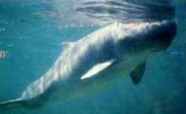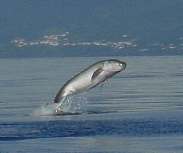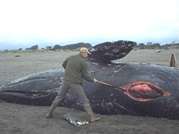9870 St Vincent Place, Glasgow, DC 45 Fr 45.
Вид: Kogia breviceps = Карликовый кашалот

- Класс: Mammalia Linnaeus, 1758 = Млекопитающие
- Инфракласс:Eutheria, Placentalia Gill, 1872 = Плацентарные, высшие звери
- Отряд: Cetacea Brisson, 1762 = Китообразные
- Семейство: Physeteridae Gray, 1821 = Кашалотовые
- Род: Kogia Gray, 1846 = Карликовые кашалоты
- Вид: Kogia breviceps Blainville, 1838 = Карликовый кашалот
Вид: Kogia breviceps Blainville, 1838 = Карликовый кашалот

(умеренные и тропические воды Тихого, Атлантического и Индийского океанов);
The Pygmy Sperm Whale is widely distributed in tropical, sub-tropical, and temperate seas. Records of sightings are scattered from Ireland and the Netherlands down the North Atlantic to the Canary Islands and Madiera, and from Nova Scotia to Cuba. Other sightings have been recorded in the South Atlantic, the Indian Ocean, and the Indo-Pacific.
Classification: The Pygmy Sperm Whale, Kogia breviceps, was classified by the Compte de Blainville in 1838, one of two species recognised in this genus. The specific name, breviceps, means 'short-headed'.
Local Names: Lesser Sperm Whale; Short-Headed Sperm Whale; Lesser Cachalot.
Description: This robust whale is really a smaller version of the Sperm Whale, with the same large, bulbous head containing spermaceti and the short narrow mouth. The snout is pointed in young animals but reverts to the familiar rectangular shape in adulthood.
Recognition at sea: The Pygmy Sperm Whale can be easily confused with Beaked Whales and the Dwarf Sperm Whale. However, Beaked Whales can usually be distinguished by their larger size, more rapid movement and - at close range - their elongated snout. The Pygmy Sperm Whale has a smaller dorsal fin than the Dwarf Sperm, and, when stranded, can be confused with a shark at first glance.
Habitat: Pygmy Sperm Whales are oceanic animals, moving across and over the continental shelf to feed.
Food & Feeding:This species of cetacean is slow-moving and hunts by stealth, so prey are probably incapable of fast movement. Primarily the Pygmy Sperm Whale eats small fish, cuttlefish, deepsea shrimps and squid.
Behaviour: There have been very few observations of the Pygmy Sperm Whale, and these suggest that it is a sluggish and slow-moving animal. The blow is inconspicuous and low, and after blowing the cetacean simply drops out of sight. It rarely approaches boats, and when startled evacuates a reddish-brown intestinal fluid as a decoy before it dives. Pods contain less than ten individuals.
Longevity: Unknown.
Estimated Current Population: Unknown.
The Influence of Man: Small numbers of the Pygmy Sperm Whale are killed by Japanese and Indonesian small whalers, but these killings are not thought to influence world population levels. However, larger numbers of this small cetacean - and many others - are caught in gill-nets, for example, off Sri Lanka. www.cetacea.org/ psperm.htm
